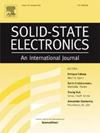Influence of substrate temperature on the electrical and photovoltaic properties of V2O5 modified n-Ge heterojunction
IF 1.4
4区 物理与天体物理
Q3 ENGINEERING, ELECTRICAL & ELECTRONIC
引用次数: 0
Abstract
Electrical and photovoltaic properties of V2O5/n-Ge heterojunction were realized by the deposition of V2O5 thin films at different substrate temperatures (room temperature (RT), TS = 150 °C and 250 °C). Optical properties of V2O5 thin films were analysed and direct allowed transitions are found most probable. Infrared measurements of V2O5 thin films reveal vibrational bands which confirms the V=O and V–O–V bonds. The shift of these bands with increasing substrate temperature suggests variation in bond lengths which might be due to strain effects in V2O5 thin films. X-ray diffraction studies were also performed for V2O5/n-Ge heterojunctions which indicates the amorphous nature of V2O5 thin films for V2O5(RT)/n-Ge heterojunction and crystallinity of the films found to be increased by increasing the substrate temperature. Current-voltage properties of V2O5/n-Ge heterojunctions at different substrate temperatures were studied and found variations in barrier properties of the devices with an increase in substrate temperature. Explored forward bias current conduction mechanisms of heterojunctions reveal trap charge limited current conduction is the dominant conduction at moderately high bias potential particularly for V2O5(TS = 150 °C and 250 °C)/n-Ge heterojunctions. Photovoltaic properties of V2O5/n-Ge heterojunctions indicate notable responsivity of V2O5 thin films under illumination (100 mW/cm2) at increased substrate temperature. The sensitivity of the V2O5(150 °C)/n-Ge heterojunction was found to be maximum than other heterojunctions whereas the photoresponsivity and specific detectivity of the heterojunction shows significant variation with bias and substrate temperature. The electrical and photoresponsive properties of V2O5 thin films on n-Ge substrate altered effectively by substrate temperature of V2O5 thin films. This triggers the variation of these properties by changing the conductivity of thin films with doping or post annealing conditions.

衬底温度对V2O5修饰n-Ge异质结电学和光电性能的影响
通过在不同衬底温度(室温,TS = 150℃和250℃)下沉积V2O5薄膜,实现了V2O5/n-Ge异质结的电学和光伏性能。分析了V2O5薄膜的光学性质,发现直接允许跃迁是最可能的。V2O5薄膜的红外测量显示振动带,证实了V=O和V - O - V键。这些条带随着衬底温度的升高而变化,表明键长可能是由于V2O5薄膜中的应变效应引起的。对V2O5/n-Ge异质结进行了x射线衍射研究,结果表明V2O5(RT)/n-Ge异质结的V2O5薄膜具有非晶性质,并且随着衬底温度的升高,薄膜的结晶度增加。研究了不同衬底温度下V2O5/n-Ge异质结的电流-电压特性,发现器件的势垒特性随衬底温度的升高而变化。研究了异质结的正向偏置电流传导机制,发现在中等偏置电位下,特别是对于V2O5(TS = 150°C和250°C)/n-Ge异质结,陷阱电荷限制电流传导是主导传导。V2O5/n-Ge异质结的光伏特性表明,在增加衬底温度(100 mW/cm2)下,V2O5薄膜具有显著的响应性。V2O5(150°C)/n-Ge异质结的灵敏度最高,而其光响应率和比探测率随偏置和衬底温度的变化有显著变化。在n-Ge衬底上,V2O5薄膜的电学和光响应性能随衬底温度的变化而变化。这通过改变掺杂或后退火条件下薄膜的电导率来触发这些特性的变化。
本文章由计算机程序翻译,如有差异,请以英文原文为准。
求助全文
约1分钟内获得全文
求助全文
来源期刊

Solid-state Electronics
物理-工程:电子与电气
CiteScore
3.00
自引率
5.90%
发文量
212
审稿时长
3 months
期刊介绍:
It is the aim of this journal to bring together in one publication outstanding papers reporting new and original work in the following areas: (1) applications of solid-state physics and technology to electronics and optoelectronics, including theory and device design; (2) optical, electrical, morphological characterization techniques and parameter extraction of devices; (3) fabrication of semiconductor devices, and also device-related materials growth, measurement and evaluation; (4) the physics and modeling of submicron and nanoscale microelectronic and optoelectronic devices, including processing, measurement, and performance evaluation; (5) applications of numerical methods to the modeling and simulation of solid-state devices and processes; and (6) nanoscale electronic and optoelectronic devices, photovoltaics, sensors, and MEMS based on semiconductor and alternative electronic materials; (7) synthesis and electrooptical properties of materials for novel devices.
 求助内容:
求助内容: 应助结果提醒方式:
应助结果提醒方式:


